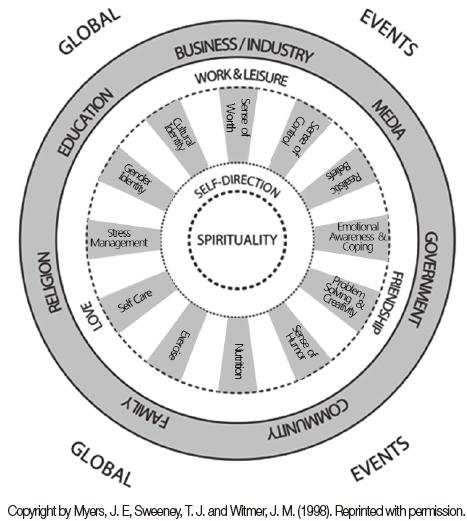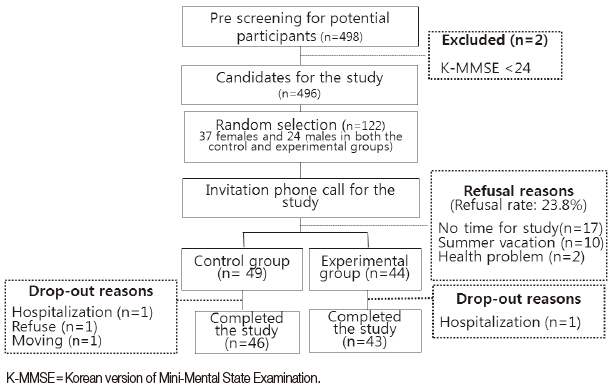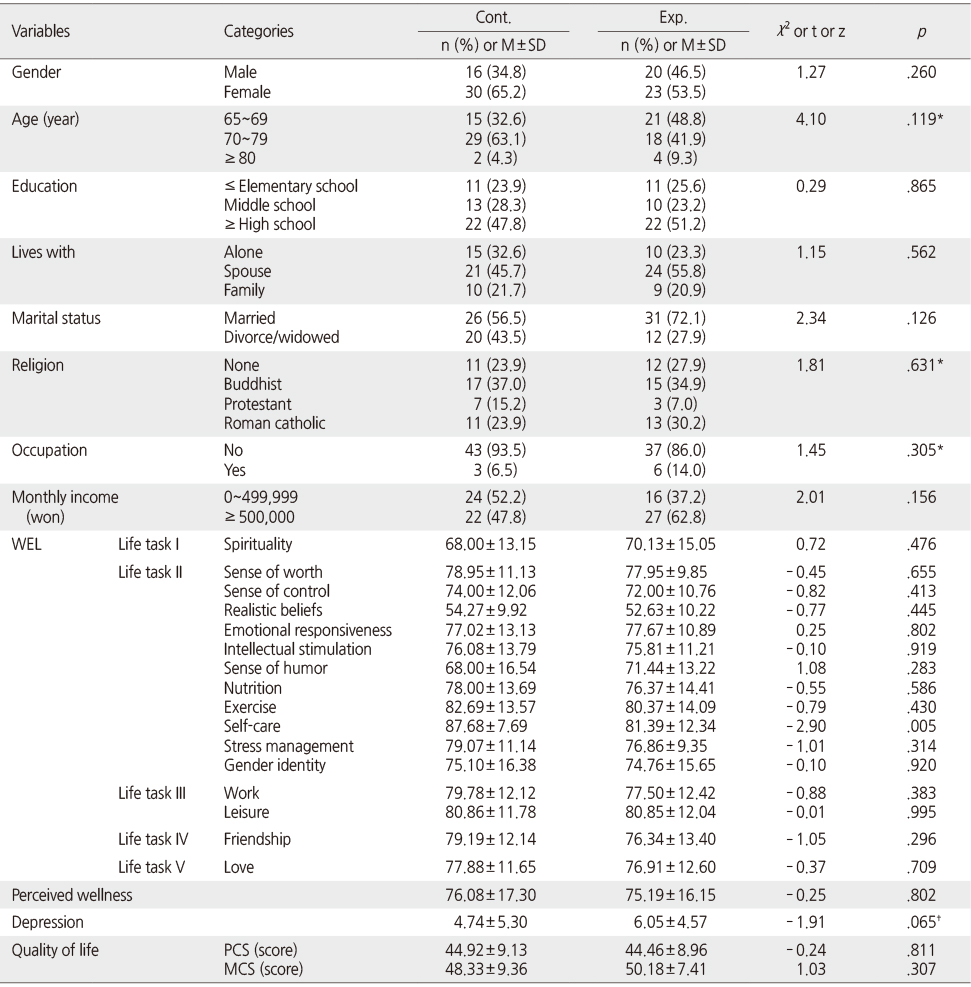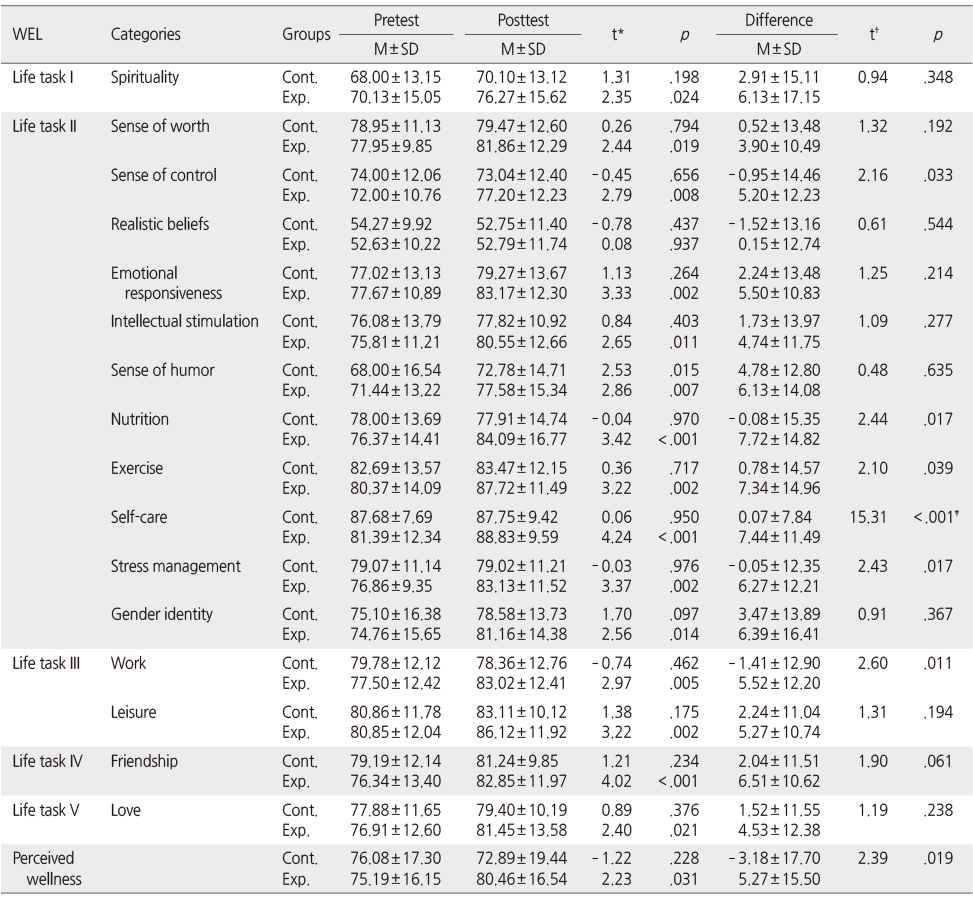Articles
- Page Path
- HOME > J Korean Acad Nurs > Volume 45(3); 2015 > Article
-
Original Article
- Wheel of Wellness Counseling in Community Dwelling, Korean Elders: A Randomized, Controlled Trial
- So-Hi Kwon
-
Journal of Korean Academy of Nursing 2015;45(3):459-468.
DOI: https://doi.org/10.4040/jkan.2015.45.3.459
Published online: June 30, 2015
College of Nursing·The Research Institute of Nursing Science, Kyungpook National University, Deagu, Korea.
- Address reprint requests to: Kwon, So-Hi. College of Nursing·The Research Institute of Nursing Science, Kyungpook National University, 680 Gukchaebosang-ro, Jung-gu, Daegu 700-422, Korea. Tel: +82-53-420-4924, Fax: +82-53-421-2758, sh235@knu.ac.kr
© 2015 Korean Society of Nursing Science
This is an Open Access article distributed under the terms of the Creative Commons Attribution NoDerivs License. (http://creativecommons.org/licenses/by-nd/4.0/) If the original work is properly cited and retained without any modification or reproduction, it can be used and re-distributed in any format and medium.
Abstract
-
Purpose
- The purpose of this study was to investigate the effects of Wheel of Wellness counseling on wellness lifestyle, depression, and health-related quality of life in community dwelling elderly people.
-
Methods
- A parallel, randomized controlled, open label, trial was conducted. Ninety-three elderly people in a senior welfare center were randomly assigned to two groups: 1) A Wheel of Wellness counseling intervention group (n=49) and 2) a no-treatment control group (n=44). Wheel of Wellness counseling consisted of structured, individual counseling based on the Wheel of Wellness model and provided once a week for four weeks. Wellness lifestyle, depression, and health-related quality of life were assessed pre-and post-test in both groups.
-
Results
- Data from 89 participants were analyzed. For participants in the experimental group, there was a significant improvement on all of the wellness-lifestyle subtasks except realistic beliefs. Perceived wellness and depression significantly improved after the in the experimental group (n=43) compared to the control group (n=46) from pre- to post-test in the areas of sense of control (p=.033), nutrition (p=.017), exercise (p=.039), self-care (p<.001), stress management (p=.017), work (p=.011), perceived wellness (p=.019), and depression (p=.031). One participant in the intervention group discontinued the intervention due to hospitalization and three in the control group discontinued the sessions.
-
Conclusion
- Wheel of Wellness counseling was beneficial in enhancing wellness for the community-dwelling elderly people. Research into long-term effects of the intervention and health outcomes is recommended.
INTRODUCTION
METHODS
1) Wellness evaluation of lifestyle (WEL)
2) The patient health questionnaire 9-Korean version (PHQ-9K)
3) Health related quality of life (SF-8™)
RESULTS
DISCUSSION
CONCLUSION
This research was supported by the National Research Foundation of Korea (NRF) and fund in the Ministry of Education, Science and Technology (No: 2011-0013126).
This research was supported by Kyungpook National University Research Fund in 2012.
- 1. Kim H, Traphagan JW. From socially weak to potential consumer: Changing discourses on elder status in South Korea. Care Manag J. 2009;10(1):32–39.ArticlePubMed
- 2. Lee MS. Structures of health inequalities of Korean elderly: Analysis of Korean longitudinal study of ageing. Health Soc Sci. 2009;25:5–32.
- 3. Statistics Korea. 2012 annual report on the causes of death statistics [Internet]. Daejeon, Author. 2013;cited 2014 January 20. Available from: http://kostat.go.kr/portal/korea/kor_nw/2/6/2/index.board?bmode=read&bSeq=&aSeq=308559&pageNo=1&rowNum=10&navCount=10&currPg=&sTarget=title&sTxt=
- 4. Helliwell JF, Putnam RD. The social context of well-being. Philos Trans R Soc Lond B Biol Sci. 2004;359(1449):1435–1446. ArticlePubMedPMCPDF
- 5. Shin KM, Cho SM, Hong CH, Park KS, Shin YM, Lim KY, et al. Suicide among the elderly and associated factors in South Korea. Aging Ment Health. 2013;17(1):109–114.ArticlePubMed
- 6. Lerner D, Rodday AM, Cohen JT, Rogers WH. A systematic review of the evidence concerning the economic impact of employee-focused health promotion and wellness programs. J Occup Environ Med. 2013;55(2):209–222. ArticlePubMed
- 7. Phillips JF. Using an ounce of prevention: Does it reduce health care expenditures and reap pounds of profits? A study of the financial impact of wellness and health risk screening programs. J Health Care Finance. 2009;36(2):1–12.PubMed
- 8. Boston RB, Clifford BM. Laws affecting wellness programs and some things they make you do. Employee Relat Law J. 2013;39(1):30–34.
- 9. Avery G, Johnson T, Cousins M, Hamilton B. The school wellness nurse: A model for bridging gaps in school wellness programs. Pediatr Nurs. 2013;39(1):13–18.PubMed
- 10. Chen IJ, Chou CL, Yu S, Cheng SP. Health services utilization and cost utility analysis of a walking program for residential community elderly. Nurs Econ. 2008;26(4):263–269.PubMed
- 11. Lee TW, Ko IS, Lee KJ. Health promotion behaviors and quality of life among community-dwelling elderly in Korea: A cross-sectional survey. Int J Nurs Stud. 2006;43(3):293–300. ArticlePubMed
- 12. Choi CY, Cho HC. The effect of degree of senior exercise participation on wellness. J Korea Soc Wellness. 2012;7(3):13–21.
- 13. Hatch J, Lusardi MM. Impact of participation in a wellness program on functional status and falls among aging adults in an assisted living setting. J Geriatr Phys Ther. 2010;33(2):71–77.PubMed
- 14. Roscoe LJ. Wellness: A review of theory and measurement for counselors. J Couns Dev. 2009;87(2):216–226.Article
- 15. Myers JE, Sweeney TJ, Witmer M. The wheel of wellness counseling for wellness: A holistic model for treatment planning. J Couns Dev. 2000;78(3):251–266.Article
- 16. Myers JE, Sweeney TJ. Wellness counseling: The evidence base for practice. J Couns Dev. 2008;86(4):482–493. Article
- 17. Tanigoshi H, Kontos AP, Remley TP Jr. The effectiveness of individual wellness counseling on the wellness of law enforcement officers. J Couns Dev. 2011;86(1):64–74. Article
- 18. Kang Y, Na DL, Hahn S. A validity study on the Korean minimental state examination (K-MMSE) in dementia patients. J Korean Neurol Assoc. 1997;15(2):300–308.
- 19. Cohen J. Statistical power analysis for the behavioral sciences. 2nd ed. Hillsdale, NJ: Lawrence Erlbaum Associates; 1988.
- 20. Faul F, Erdfelder E, Lang AG, Buchner A. G*Power 3: A flexible statistical power analysis program for the social, behavioral, and biomedical sciences. Behav Res Methods. 2007;39(2):175–191.ArticlePubMedPDF
- 21. Myers JE, Sweeney TJ. Counseling for wellness: Theory, research, and practice. Alexandria, VA: American Counseling Association; 1998.
- 22. Donnelly PL, Kim KS. The patient health questionnaire (PHQ-9K) to screen for depressive disorders among immigrant Korean American elderly. J Cult Divers. 2008;15(1):24–29.PubMed
- 23. Kroenke K, Spitzer RL, Williams JB. The PHQ-9: Validity of a brief depression severity measure. J Gen Intern Med. 2001;16(9):606–613.ArticlePubMedPMC
- 24. Hattie JA, Myers JE, Sweeney TJ. A factor structure of wellness: Theory, assessment, analysis, and practice. J Couns Dev. 2004;82(3):354–364. Article
- 25. Villalba JA, Myers JE. Effectiveness of wellness-based classroom guidance in elementary school settings: A pilot study. J Sch Couns. 2008;6(9):1–31.
- 26. Lee DG, Park HJ. Cross-cultural validity of the frost multidimensional perfectionism scale in Korea. Couns Psychol. 2011;39(2):320–345. ArticlePDF
- 27. Ashbaugh A, Antony MM, Liss A, Summerfeldt LJ, McCabe RE, Swinson RP. Changes in perfectionism following cognitive-behavioral treatment for social phobia. Depress Anxiety. 2007;24(3):169–177. ArticlePubMed
- 28. Clifford A, Rahardjo TB, Bandelow S, Hogervorst E. A cross-sectional study of physical activity and health-related quality of life in an elderly Indonesian cohort. Br J Occup Ther. 2014;77(9):451–456. ArticlePDF
- 29. Kim JI. Levels of health-related quality of life (EQ-5D) and its related factors among vulnerable elders receiving home visiting health care services in some rural areas. J Korean Acad Community Health Nurs. 2013;24(1):99–109. Article
- 30. Fotoukian Z, Shahboulaghi FM, Khoshknab MF, Mohammadi E. Concept analysis of empowerment in old people with chronic diseases using a hybrid model. Asian Nurs Res (Korean Soc Nurs Sci). 2014;8(2):118–127. ArticlePubMed
REFERENCES
Figure & Data
REFERENCES
Citations

- The Effect of Lifestyle Interventions on Anxiety, Depression and Stress: A Systematic Review and Meta-Analysis of Randomized Clinical Trials
Sohrab Amiri, Nailah Mahmood, Syed Fahad Javaid, Moien AB Khan
Healthcare.2024; 12(22): 2263. CrossRef - Lifestyle interventions improving health-related quality of life: A systematic review and meta-analysis of randomized control trials
Sohrab Amiri, Nailah Mahmood, Sameeha Junaidi, Moien AB Khan
Journal of Education and Health Promotion.2024;[Epub] CrossRef - Meaning of wellness in caring science based on Rodgers's evolutionary concept analysis
Monica Eriksson, Anette Ekström‐Bergström, Susann Arvidsson, Henrika Jormfeldt, Stina Thorstensson, Ulrica Åström, Ingela Lundgren, Åsa Roxberg
Scandinavian Journal of Caring Sciences.2024; 38(1): 185. CrossRef - Non–Exercise-Based Interventions to Support Healthy Aging in Older Adults: A Systematic Review and Meta-Analysis of Randomized Controlled Trials
Wei Qi Koh, Nutyathun Wora, Natasha Wing Laam Liong, Kristiana Ludlow, Nancy A Pachana, Jacki Liddle, Patricia C. Heyn
The Gerontologist.2024;[Epub] CrossRef - The Effect of Lifestyle Interventions on the International Classification of Functioning, Disability and Health Participation Domain in Older Adults: A Systematic Review and Meta-Analysis
Sachi O’Hoski, Stephanie Chauvin, Brenda Vrkljan, Marla K Beauchamp, Patricia C Heyn
The Gerontologist.2022; 62(6): e304. CrossRef - Wellness and wellness counseling: History, status, and future
Michael D. Brubaker, Thomas J. Sweeney
Counselor Education and Supervision.2022; 61(1): 25. CrossRef - Behaviour change techniques in personalised care planning for older people: a systematic review
Sadia Ahmed, Anne Heaven, Rebecca Lawton, Gregg Rawlings, Claire Sloan, Andrew Clegg
British Journal of General Practice.2021; 71(703): e121. CrossRef - Lifestyle medicine for depression: A meta-analysis of randomized controlled trials
Vincent Wing-Hei Wong, Fiona Yan-Yee Ho, Nga-Kwan Shi, Jerome Sarris, Ka-Fai Chung, Wing-Fai Yeung
Journal of Affective Disorders.2021; 284: 203. CrossRef - Intervención multidimensional preventiva de dependencia de personas mayores del centro integral para el envejecimiento feliz
María Teresa Valenzuela, Claudia Rodríguez, Ignacio Pérez, Luis Sarmiento, Pamela San Martín
Revista Médica Clínica Las Condes.2021; 32(4): 466. CrossRef - A review on healthy ageing interventions addressing physical, mental and social health of independent community-dwelling older adults
Betsy Seah, Yanika Kowitlawakul, Ying Jiang, Emily Ang, Srinivasan Chokkanathan, Wenru Wang
Geriatric Nursing.2019; 40(1): 37. CrossRef - Intervenções educativas para promoção da saúde do idoso: revisão integrativa
Khelyane Mesquita de Carvalho, Cynthia Roberta Dias Torres Silva, Maria do Livramento Fortes Figueiredo, Lídya Tolstenko Nogueira, Elaine Maria Leite Rangel Andrade
Acta Paulista de Enfermagem.2018; 31(4): 446. CrossRef - Validity and reliability of a Korean version of the wellness evaluation of lifestyle (K-WEL)
Hee Sook Kim, Yeonungsuk Song, So-Hi Kwon
Journal of the Korean Data and Information Science Society.2016; 27(6): 1609. CrossRef


Figure 1
Figure 2
Homogeneity Test of Socio-demographic Characteristics, WEL, Depression and Quality of Life between Groups
*Fisher's exact test;†Wilcoxon's rank sum test PHQ-9K=Patient Health Questionnaire-9 Korean; PCS=Physical component scale; MCS=Mental component scale;
WEL=Wellness evaluation of lifestyle; Cont.=Control group (n=46); Exp.=Experimental group (n=43).
Between-group Comparison of Changes in Wellness Lifestyle
*Paired t-test; †Independent t-test; ‡Analysis of covariance; WEL=Wellness Evaluation of Lifestyle; Cont.=Control group (n=46); Exp.=Experimental group (n=43).
Between-group Comparison of Changes in Depression and Quality of Life
*Paired t-test; †Independent t-test; ‡Wilcoxon signed-rank test; §Wilcoxon rank-sum test; Cont.=Control group (n=46); Exp=Experimental group (n=43);
PCS=Physical component scale; MCS=Mental component scale.
*Fisher's exact test;†Wilcoxon's rank sum test PHQ-9K=Patient Health Questionnaire-9 Korean; PCS=Physical component scale; MCS=Mental component scale; WEL=Wellness evaluation of lifestyle; Cont.=Control group (n=46); Exp.=Experimental group (n=43).
*Paired t-test; †Independent t-test; ‡Analysis of covariance; WEL=Wellness Evaluation of Lifestyle; Cont.=Control group (n=46); Exp.=Experimental group (n=43).
*Paired t-test; †Independent t-test; ‡Wilcoxon signed-rank test; §Wilcoxon rank-sum test; Cont.=Control group (n=46); Exp=Experimental group (n=43); PCS=Physical component scale; MCS=Mental component scale.
 KSNS
KSNS
 E-SUBMISSION
E-SUBMISSION





 Cite
Cite

